Leadville mining district

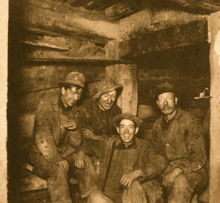
The Leadville mining district, located in the Colorado Mineral Belt, was the most productive silver-mining district in the US state of Colorado. It is located immediately east of the town of Leadville. Oro City, an early Colorado gold placer mining town located about a mile east of Leadville in California Gulch, was the site of the single richest placer gold strike in the entire Pikes Peak gold rush. In just seven years, ten tons of gold were mined from California Gulch.[1]
Cumulative production through 1963 was 240 million troy ounces of silver, 3 million troy ounces of gold, 987 million tonnes of lead, 712 million tonnes of zinc, and 48 million tonnes of copper. The district also produced byproduct bismuth, and iron-manganese ore.[2]
History


%2C_1833-1880.jpg)
Gold was discovered in the area in late 1859, during the Pike's Peak Gold Rush. However the initial discovery, where California Gulch empties into the Arkansas River, was not rich enough to cause excitement. On April 26, 1860, Abe Lee made a rich discovery of placer gold in California Gulch, about a mile east of Leadville, and Oro City was founded at the new diggings.[3][4] By July 1860, the town and surrounding area had a population of 10,000 and an estimated $2 million in gold was taken out of California Gulch and nearby Iowa Gulch by the end of the first summer. Within a few years the richest part of the placers had been exhausted, and the population of Oro City dwindled to only several hundred. Many claims were consolidated, and worked by ground sluicing. A ditch was dug in 1877 to provide water for hydraulic mining, but the hydraulic mining was reported to be unsuccessful.[5]
In 1874, gold miners at Oro City discovered that the heavy sand that impeded their gold recovery was the lead mineral cerussite, that carried a high content of silver. Prospectors traced the cerussite to its source, and by 1876, had discovered several lode silver-lead deposits. The city of Leadville was founded near to the new silver deposits in 1877 by mine owners Horace Austin Warner Tabor and August Meyer,[6] setting off the Colorado Silver Boom. By 1880, Leadville was one of the world's largest silver camps, with a population of over 40,000. The city's fortunes declined with the repeal of the Sherman Silver Purchase Act in 1893 which resulted in a drop in the price of silver, although afterwards there was another small gold boom. Mining companies came to rely increasingly on income from the lead and zinc.
The last active mine in the district, the Black Cloud mine, owned by ASARCO, closed in 1999.[7]
Geology
The district is a highly faulted area, intruded with Tertiary quartz monzonite porphyries, on the east side of the Arkansas River graben, part of the Rio Grande Rift system.
The silver occurs associated with manganese and lead in veins, stockworks, and manto-type deposits in the Mississippian Leadville Limestone (here a dolomite), the Devonian Dyer Dolomite, and the Ordovician Manitou Dolomite. Ore minerals are pyrite, sphalerite, and galena, in jasperoid and manganosiderite gangue. In upper levels, the ore minerals are oxidized to cerussite, anglesite, and smithsonite.
Environmental damage related to mining operations

Mining, mineral processing and smelting activities in the area have produced gold, silver, lead and zinc for more than 130 years. Wastes generated during the mining and ore processing activities contained metals such as arsenic and lead at levels posing a threat to human health and the environment. These wastes remained on the land surface and migrated through the environment by washing into streams and leaching contaminants into surface water and groundwater. The site was added to the U.S. Environmental Protection Agency (EPA) National Priorities List in 1983,. Investigation of the site began in the mid-1980s. Since 1995, EPA and the potentially responsible parties have conducted removal and remedial activities to consolidate, contain and control more than 350,000 yards of contaminated soils, sediments and mine-processing wastes. Cleanups by the potentially responsible parties have involved drainage controls to prevent acid mine runoff, consolidation and capping of mine piles, cleanup of residential properties and reuse of slag. As of September 2011, most of the cleanup had been completed so current risk of exposure is low, although pregnant women, nursing mothers and young children are still encouraged to have their blood-lead levels checked.[8]
Drainage tunnels
As in many mining districts, as the mines extended deeper, keeping the water pumped out of the workings became a major expense. To more economically drain the mines, two tunnels were driven to allow the water to drain by gravity. Water from both tunnels ultimately flows into the Arkansas River.
Yak tunnel
The Yak tunnel, 3.5 miles long and built between 1895 and 1923 to drain the southern part of the district, has its outlet in California Gulch east of the town of Leadville. The tunnel became part of the California Gulch Superfund site in 1983. In October 1985, a large surge of water from the Yak tunnel reached the Arkansas River, and elevated the dissolved metals content of the river for tens of miles downstream. Water flowing from the tunnel has been treated by its owner, ASARCO, since June 1991, to remove metals.
Leadville tunnel
The Leadville tunnel was started in 1943 by the US Bureau of Mines to drain the mines of the northern part of the district, and so increase metal production. The tunnel has its outlet north of the town of Leadville, on the East Fork of the Arkansas River. In 1959 the US Bureau of Reclamation bought the tunnel for US$1, as a source for irrigation water.
Since March 1992, the Bureau of Reclamation has treated the water flowing out of the tunnel, to remove dissolved metals and bring the water quality into compliance with the Clean Water Act.
Collapses within the tunnel that began in 1995 partially blocked flow, and have created a large reservoir of an estimated one billion gallons (3.8 million cubic meters) of water within the tunnel behind the collapse. In February 2008, concerns became public that if the collapse dam should suddenly fail, as has happened in other mine drainage tunnels in Colorado (such as the Yak tunnel and the Argo Tunnel), a large slug of contaminated water would suddenly flow out of the tunnel, overwhelm the treatment facilities, and flow into the Arkansas River. The rise in water level inside the tunnel has caused water with high concentrations of dissolved metals to leak out to the ground surface through springs.[9]
Opinions as to the threat posed varied widely. County Commissioner Mike Hickman said "If it blows, it could be a national catastrophe, not only to Leadville and Lake County but to the entire Arkansas River." On the other hand, Leadville Mayor Bud Elliott stated "This is what happens when you create an emergency when there isn't one."[10] On June 30, 2008, the Bureau of Reclamation issued a report that concluded that a sudden burst of water from the tunnel was unlikely, and that the tunnel posed "no imminent public safety hazard."[11]
On 27 February 2008, the US EPA began pumping 150 gallons per minute (216 thousand gallons per day, 818 cubic meters per day) from the tunnel system, to relieve water pressure upstream from the blockage. The water, pumped from the Gaw mine shaft, was clean enough to discharge to the Arkansas River without treatment.[12] Meanwhile, the EPA drilled a new well into the tunnel system; a pump test was completed in early June 2008 to determine optimal pumping rate.[13]
Tour and visitor attractions

The Mineral Belt National Recreation Trail is an 11.6 mile all-season biking/walking trail that loops around Leadville and through its historic mining district. In part the trail follows old mining-camp railbeds. Several signs along the way provide historical snippets about Leadville's colorful past.
The "Route of the Silver Kings" is a driving tour of the 20-square-mile historic mining district surrounding Leadville. The tour includes mines, power plants, ghost towns and mining camps. [14]

The National Mining Hall of Fame and Museum occupies 71,000 square feet (6,600 m2). Major exhibits include an elaborate model railroad,[15] a walk-through replica of an underground hardrock mine,[16] the Gold Rush room, with many specimens of native gold,[17] a large collection of mineral specimes,[18] and a mining art gallery.
The Matchless mine and cabin, former home of Baby Doe Tabor, is open as a tourist attraction during the summer.
See also
Gallery
-

Gold-Quartz
-
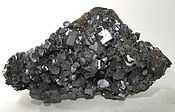
Galena--Black Cloud Mine
-

Cerussite
-
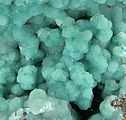
Smithsonite-Baryte
-
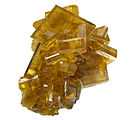
Baryte
-

Vivianite
-
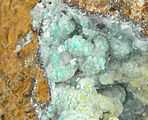
Cerussite-Rosasite-Azurite
-

Pyrite
-

Wulfenite-Rosasite
-
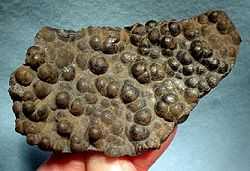
Goethite
Notes
- ↑ http://cozine.com/1994-june/oro-city-plans-to-rise-again-in-1995/
- ↑ Ogden Tweto (1968) Leadville District, Colorado, in Ore Deposits of the United States 1933-1967, New York: American Institute of Mining Engineers, p.681-705
- ↑ "From the Arkansas River," Rocky Mountain News, 16 May 1860, p.2.
- ↑ Mike Flanigan, "Leadville, Cloud City," Denver Post Magazine, 1 Sept. 1985, p.22.
- ↑ Ben H. Parker Jr. (1974) Gold Placers of Colorado, book 2, Quarterly of the Colorado School of Mines, v.69, n.4, p.13-19.
- ↑ Meyer, August 1851–1905, Parks -georgekessler.org
- ↑ Steve Lipsher, "Mine no more," Denver Post, 18 July 1999, p.1B.
- ↑ http://www.epa.gov/Region8/superfund/co/calgulch/
- ↑ Steve Lipsher, "Feds also fear toxic blowout," Denver Post, 15 Feb. 2008, p.1B.
- ↑ Steve Lipsher, "Wading through rhetoric," Denver Post, 25 Feb. 2008, p.1A.
- ↑ P. Solomon Banda, "Trapped water in Leadville no threat, feds say," Denver Post, 1 July 2008, p.4B.
- ↑ Anne C. Mulkern, "Bills shift Leadville tunnel load to feds," Denver Post, 29 Feb. 2008, p.1B.
- ↑ EPA press release (4 June 2008): EPA completes pump test at Leadville Mine Drainage Tunnel
- ↑ Route of the Silver Kings (scroll down)
- ↑ National Mining Hall of Fame and Museum - Leadville, Colorado, minerals, gems, history
- ↑ National Mining Hall of Fame and Museum - Leadville, Colorado, minerals, gems, history
- ↑ National Mining Hall of Fame and Museum - Leadville, Colorado, minerals, gems, history
- ↑ National Mining Hall of Fame and Museum - Leadville, Colorado, minerals, gems, history
References
- US Bureau of Reclamation (April 2005): A summary of existing reports which have examined the Leadville mine drainage tunnel (LMDT) discharge to the East Fork of the Arkansas River, Colorado
- US Bureau of Reclamation (15 February 2008): Reclamation partners with Lake County, Colorado and other federal agencies to address public concerns at Leadville mine drainage tunnel
- US Bureau of Reclamation (11 Mar. 2008): Reclamation successfully tests water treatment plant at Leadville Mine Drainage Tunnel
- US Bureau of Reclamation (30 June 2008): Leadville Mine Drainaige Tunnel risk assessment shows residents are safe